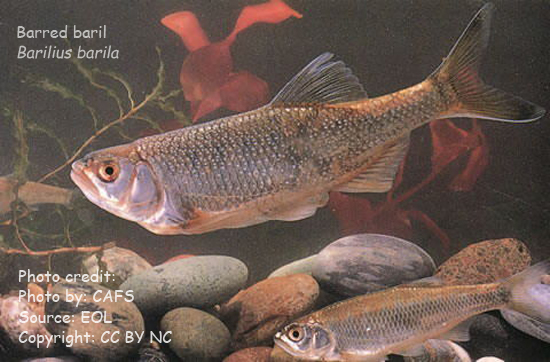
Freshwater prawn (Macrobrachium rosenbergii) has become an important subject in recent years to the rural peoples for their livelihood, to the enterprises and exporters for raw materials and to the researchers for searching new technologies suitable for the different climatic zones of Bangladesh. The production technology of prawn polyculture is not found with a long history as with the indigenous technology of gher (an enclosed area inside a larger saline pond) farming developed in south-western Bangladesh. Apart from the gher farming which is more frequently criticized with its effects on environment and thereby sustainability of the practice, farmers are found to introduce the prawn in pond with carps to earn the maximum benefit over the carp polyculture technique only. Polyculture of prawn with carp is found more feasible over the monoculture technique to reduce the over fertility of the pond and to increase the mean weight of prawn, the most desirable species in aquaculture.
Although having a day by day increase of prawn farming units in one of the larger prawn producer country like Bangladesh, the processing units of raw materials are not getting the satisfactory level. This means that efforts are necessary in our research system to increase the prawn in pond under different agroecological zones. Some efforts are found on polyculture of prawn with carps using supplementary feed in ponds. But carp species used, supplementary feeds provided and application coverage with shorter geographical area by research resulted some basic questions or arguments like –
- Which co-species can be taken for more favorable prawn production?
- Since feed is found today as one of the vital problem specially to the poor farmers for its high cost involvement in aquaculture then-
- What will be the feeding strategy while integrating prawn with carps?
- Fishes other than surface feeding carps will be stocked or not to reduce the feed sharing and to increase the mean weight of prawn?
- Almost similar package found by the earlier research conducted in a limited scale may not be suitable for all the geographic locations of Bangladesh.
Under the above circumstances the author as an specialist of critical soil aquaculture with gaining an earlier experience of aquaculture technology development and dissemination specially in the southern part of Bangladesh through ATDP (Agrobased Induutries and Technology Development Project) and GNAEP (Greater Noakhali Aquaculture Extension Project) and also the experience of livelihood research under LWI (Land Water Interface) in two major floodplains of Bangladesh like the Ganges river floodplain and the Jamuna river floodplain as well as the experience of aquaculture research through ICLARM – The World Fish Centre in almost all the AEZs of Bangladesh, experimentally demonstrated the technical feasibility of prawn based carp polyculture in twelve ponds (average area of 0.1ha and water depth of 1.0m) under Rajshahi district, a northern part of Bangladesh with the support of BFRF (Bnagladesh Fisheries Research Forum) during September 2006 to February 2007. Growth performance was evaluated under four different stocking densities of prawn (M. rosenbergii) (20, 40, 60 and 80/40m2) with a similar stocking density of surface feeding carps (silver carp, H. molitrix -12/40m2 and catla, C. catla – 8/40m2).

A training module suitable for the trial farmers was developed with the inputs taken from the line expertise related to biology, water quality, aquaculture, feed and disease of prawn under the department of fisheries, university of Rajshahi. Followed by the development of training module a two days long training was also conducted for the farmers prior to start the experiment. Strong motivation was also provided to the farmers while participating the renowned national coastal aquaculture specialist from the faculty of Fisheries under Bangladesh Agricultural University, Mymensingh including the proficient biologists from the department of Zoology under the university of Rajshahi in the inaugural session of the training conducted. Monitoring for feed preparation and application, water quality and growth was done as a regular basis.

All the ponds were subjected to the same feeding (rice bran-50% + fishmeal-20% + mustard oil cake-30% twice daily at an average rate of 5% of the prawn body weight regime). Prawn juveniles were collected from a government fish farm and hatchery located in Natore, Bangladesh. The initial mean stocking weight of M. rosenbergii, H. molitrix and C. catla was 2.39 ±0.10 g, 49.17 ±6.59 g and 50.10 ±1.09 g, respectively. Mean final weight of prawn was found as 88.1g after six months culture. Combined yield of prawn and carp varied from 2721 kg/ha (prawn-15% and carp-85%) to 2918kg/ha (prawn-38% and carp-62%) in ponds of lowest and highest stocking of prawn, respectively. During experiment the minimum water temperature was recorded as 16.8°C in January and February whereas the maximum was recorded as 30.9°C in September. The experiment was conducted in almost cooler season and the findings indicated that higher prawn yield can be obtained without a significant change in carp yield in ponds under northern Bangladesh.
Actually most of the fish farmers of northern Bangladesh are found more vulnerable than others because of the soil – water quality, seasonality of the ponds, poor fish yield and less income from the traditional carp culture. Regarding the climatic and vulnerability context, development of short cycle aquaculture of valuable species in pond and proper uses of other available aquatic resources are considered important for this region. In hence freshwater prawn in the form of pond, rice plot and cage aquaculture have greater potentials for the improvement in livelihood in future. Also there are constraints like unavailability of quality seeds in time. Present effort is not sufficient for wider adoption of prawn farming technology in northern Bangladesh but it can be considered as a seed of hope as the Department of Fisheries (DoF) has already taken initiatives for juvenile supply to the farming units through the development of prawn nursery.
Visited 1,576 times, 1 visits today | Have any fisheries relevant question?

